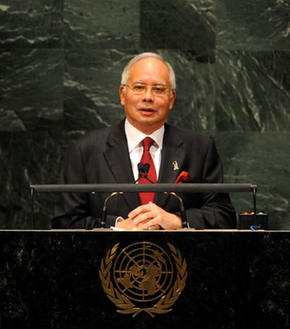Prospects for China-ASEAN Relations
|
 |
|
Malaysian Prime Minister Datuk Seri Najib Tun Razak hailed the China-ASEAN FTZ as a milestone in economic cooperation between participating countries. |
Challenges to ASEAN
There are three reasons why the U.S. can play on the South China Sea issue. The first is the absence of a new security cooperation framework in East Asia. Regional cooperation is confined to the economic sector. That in other realms is sluggish and fraught with problems harking back to the Cold War period. This is why the Cold War era alliance is still at work in the Asia-Pacific today. Second is that of the inherent problems within ASEAN. The expansion of the organization brings into sharp relief the growing diversity of individual member states’ strategic goals and interests, but there is scant coordination in this regard. Since Lee Kuan Yew, Datuk Seri Mahathir Bin Mohamad, and Haji Mohammad Suharto bowed out, the ASEAN leadership has weakened, and its efficient, coordinative system gone. What’s more, core members of the organization show waning interest in regional integration. Third is the question of balance between the two big powers – China and the U.S. Out of pragmatic concerns, ASEAN members hope to reap gains from both China and the U.S., namely, to gain economic benefits from China and security guarantees from the U.S. However, they would also like to see checks and balances between the two major countries that would give them more strategic autonomy and leeway.
In light of the roadblocks that the U.S. has set up to China-ASEAN cooperation, ASEAN faces three challenges. First, if ASEAN members lack the resolve to advance economic integration and the will to build a new regional security framework, the regional organization risks being substituted or marginalized by U.S.-led regional security and economic schemes. It might then deteriorate from a core political and economic force in the Asia-Pacific to a loose platform for dialogues, or even slip into demise. Second, should the ASEAN pivotal agenda be swayed by the South China Sea issue, the disparate stances of its members, arising from their different needs and pursuits, may lead to dissolution of the organization. Third, in the balance of power game, ASEAN will not benefit from any escalation of the South China Sea conflicts, as this would multiply the odds of confrontation between China and the U.S. ASEAN would not relish clashes between the two powerful countries because its members could not withstand the consequences.
Future Expectations
There are three factors that would contribute to China and ASEAN circumventing the South China Sea trap.
First, strengthened economic cooperation between China and ASEAN makes it impossible for either side to substitute their economic interdependence for that with other countries. Over the period 2002 to 2013, bilateral trade soared from US $54.767 billion to US $443.61 billion. China is now ASEAN’s largest trade partner, and ASEAN has been China’s No.3 trade partner, fourth largest export market, and second largest import source for three successive years. August this year saw the start of negotiations to build an upgraded version of the China-ASEAN Free Trade Zone. It took just four years to establish and upgrade the FTZ, so testifying to both sides’ resolve to advance their economic cooperation. It is expected that economic cooperation between China and ASEAN will proceed on the tri-tracks of an upgraded FTZ, the Regional Comprehensive Economic Partnership (RCEP), and the Maritime Silk Road. China has consequently set the goal of increasing bilateral trade to more than US $1 trillion by 2020. Economic cooperation is projected to continue providing the primary impetus towards regional peace and stability.

